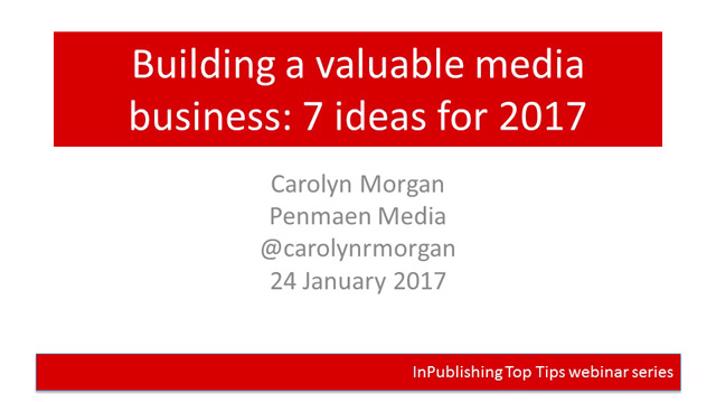
Subscriptions
Q: What are the best ways to build subscribers?
A: Start by being totally clear about your audience – they should be highly engaged in your content. Research what their information needs are, maybe through a user group or phone interviews. Make sure your content delivers this. Establish a wide funnel of prospects, eg e-newsletter subscribers, and then market your paid proposition to them.
Q: Can you outline the components of a typical successful membership package?
A: In B2B, what makes it membership rather than a subscription is the events and networking opportunity – so work out who your audience want to share best practice or do business with. In B2C, it’s more about exclusive offers and experiences.
Content
Q: If you already own a successful print product... how do you decide which parts of it should be part of the digital proposition to make it successful?
A: First step is to review your analytics and talk to your audience to see how they use your content. A good idea is to arrange a workshop with the editorial team to go through different topic areas in detail to establish the guidelines on what goes where.
Q: For a free B2B website, what are the risk and benefits of introducing a paywall?
A: You need to carefully research what content is most valued and the audience might pay for. Ideally this should be new content, as making free content paid-for is rarely popular. A good intermediate step is introducing free registration. A B2B publisher I worked with recently did this, and their email registration stats increased fourfold, plus they got lots of insight into what users were reading.
Advertising
Q: Where do you see the future of print advertising?
A: Print will still exist in a few years, but it will be smaller. In niche markets, there is certainly a value in building branding via print ads in more “coffee table” publications. Some B2B publishers however are moving away from print altogether. I recommend you try to diversify.
Q: What do you mean by 'self-service' directories?
A: I can see a polarisation of advertising. For bigger clients with higher spend, publishers can justify the extra work involved in bespoke content driven solutions. But directories, for sale listings, jobs or small ads that are lower ticket will only be cost effective for publishers if there is an online self-service tool so that advertisers can post and pay for their own ads.
Q: How should a traditional print advertiser client allocate their budget between print and digital?
A: This depends on the client’s marketing objectives – do they want direct sales, to build a database, generate leads or change people’s mind about a product? Once you have a measure of their objectives, then build a campaign across print and digital that can deliver what they want. As you discover what works, the split between print and digital media might change.
Q: With plummeting display ad revenue in some areas, doesn't this undermine many websites? Isn't it time for a completely new model rather than trying to change existing offerings, ie launching something new not reforming existing media?
A: The starting point has to be the audience you serve, and what information they want. It may well make sense to create a new brand to deliver this, especially if you are moving to a paid subscription service. But if your traditional brand is strong, you may want to make the connection evident, to add credibility.
Marketing
Q: How important is the humble e-newsletter to modern publishers?
A: I think email still has a few years of life left, even if millennials prefer messaging and chat apps. Most publishers still find that a good editorial e-newsletter is their best traffic driver, so long as it is mobile friendly. And B2B media still rely on email for paid conferences and other premium products. Plus, advertisers in general find it a measurable channel.
Q: We've had a lot of success with building a Twitter audience, but Facebook has been more difficult. Do you have any tips on boosting a Facebook following?
A: Facebook is challenging for B2B brands, as generally their audience is not in a business mode when they are using it. But The Economist has very successfully used images, cartoons, charts, slideshows and videos to build engagement and drive people back to their website, so take a look at how they do it.
Valuations
Q: Typically, what percentage of proprietary v third-party owned assets would a prospective buyer/investor expect to see being used in a successful media/publishing business?
A: As regards media brands or “titles” then wholly owned brands are far more attractive than those that are in some way licensed or dependent on a third-party contract. Within a media brand, it is perfectly acceptable to have some content that is provided by a third party, so long as the media brand is truly adding value eg via analysis or comment. But the more proprietary data and content you can amass the better.
Q: Any examples of SME B2B businesses that have done many of the things you recommend?
A: Econsultancy, whilst being digital only, pioneered the Free to Reg to Paid sub to events business model, and was bought by Centaur for £12m. Procurement Leaders has developed a tiered membership / subscription model. Sift Media is excellent at content based marketing solutions for its advertisers.
Trends
Q: Are you optimistic or gloomy about media revenues in 2017?
A: Depends on how you define media revenues. Advertising will be tough, as it moves towards mobile, where Facebook and Google dominate. But if we consider media revenues as all the products and services we can sell to our audience, from events to reports to merchandise and premium subs, then the only limit is our imagination (and sweat).
A recording of the webinar can be viewed here.












